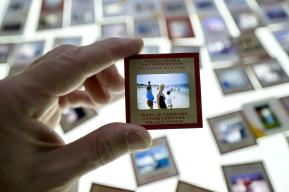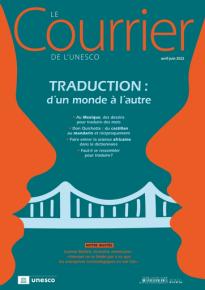فكرة
كبش الفداء، دعامة أساسية للفكر التآمري

قد تساعد الأزمات الاجتماعية على انتعاش نظريات المؤامرة ورواجها. لكن جان ـ ويليمفان برويجيان يرى أنّ هذا التفسير غير كاف بل يجب أن يكون متبوعا بوجود مجموعة اجتماعية معينة يُنظر إليها كمعادية وتصنّف كضارّة.
أستاذ مشارك في قسم علم النفس التجريبي والتطبيقي بالجامعة الحرة بأمستردام، ومدير بحوث في المعهد الهولندي للعلوم الجنائية ومكافحة الإجرام (NSCR).
عندما اقتحمت الحشود الغاضبة من مؤيّدي دونالد ترامب ـ رئيس الولايات المتحدة آنذاك ـ مبنى الكابيتول في واشنطن العاصمة في 6 يناير 2021، كان يحرّكها الاعتقاد في وجود مؤامرة سَرقت منها نتائج الانتخابات الرئاسية.
وفي هولندا، أثارت التّدابير التّقييدية ـ ومنها على وجه الخصوص فرض حظر التجوّل ـ لمكافحة جائحة كوفيد ـ 19 احتجاجات عنيفة في يناير 2021 تحوّلت إلى أحداث شغب وتدمير لعدد من الممتلكات في جميع أرجاء البلاد. وكان عدد كبير من هؤلاء المتظاهرين يعتقد في وجود مؤامرة تُحاك من طرف حكومة تُضمر نوايا سيئة أو تُبالغ من مخاطر فيروس كورونا بهدف قمع السكان أو جعل التّطعيم إجبارياً باستخدام مواد غامضة من شأنها السّيطرة على العقول.
والسّؤال الذي يُطرح هنا يخصّ دور نظريّات المؤامرة في مظاهر الاستقطاب والتطرّف؟ كثيراً ما يقال إن حالات الأزمة المجتمعية تعزّز فكر المؤامرة لدى المواطنين بمن فيهم المندمجين تماما والذين لا تبدو عليهم أيّ علامات اضطراب. فعندما ينتاب المرء شعورٌ بالضّيق ـ لعدم الوثوق بالمستقبل، أو فقدان السّيطرة على النّفس، أو القلق ـ، فمن الطبيعي أن يبذل جهدا ذهنيّا لإضفاء معنى ما على محيطه المادّي والاجتماعي ومحاولة فهمه. وقد أسهمت ردود الفعل من هذا القبيل إسهاماً كبيراً في بقائنا على قيد الحياة طيلة مسيرة الإنسان التطوريّة لأن ما يُحفّزنا على فهم ماهية التّهديدات وأسبابها يزيد من قدرتنا على توقّع هذه التّهديدات والاستعداد لها.
مجموعة معادية يسهل التعرّف عليها
بيد أنّ هذا المسار لئن يمثّل جزءا من المُرْبِكة أو اللّغز يظلّ غير كاف لتفسير عقليّة المؤامرة على نحو كامل. فالأزمات لا تُنتج بالضّرورة عقلية المؤامرة. عندما وقعت الهجمات الإرهابية في 11 سبتمبر 2001 في مدينة نيويورك، اعتقد العديد من المواطنين في النّظريات التّآمرية التي مفادها أن الجريمة نُفّذت بتواطؤ مع أطراف من داخل الحكومة الأمريكية. بيد أنّ العديد من المواطنين الآخرين أيّدوا تأييدا مطلقا الرئيس بوش الذي حصد بعد ذلك أعلى نسبةٍ شعبيّة، على الإطلاق، لرئيس أمريكي .
وإذا كان العدد المرتفع للمواطنين الذين يؤمنون بالنّظريات التآمرية فيما يخصّ فيروس كوفيد-19 لافتا للانتباه –%26 من المواطنين الكنديين و%39 من المواطنين الأستراليين يعتقدون، في مايو 2020، أن الفيروس التّاجي سلاح بيولوجي صُنع في المخابر- فإنّ عددا أكبر من المواطنين لا يصدّقون هذه النّظريات.
ومن شروط ترسّخ فكر المؤامرة في الأذهان توفّر عامل واحد على الأقل يتمثّل في وجود مجموعة خارجيّة معادية، بمعنى فئة اجتماعية تكون محلّ ريبة واحتقار عميق وتُحوَّل إلى كبش فداء في الوقت المناسب بما يسهّل الفهم البسيط والمباشر لحالة الأزمة المجتمعية مثل الجائحة أو الهجوم الإرهابي أو الانتخابات المخسورة، فتنتشر تبعا لذلك تفسيرات من قبيل "هم" الذين خلقوا هذا الوضع عَمْدًا، وأنّ في الأمر مؤامرة خبيثة وإجرامية حاكتها هذه المجموعة. كما أنّ إيجاد كبش فداء يمكن أن يكون مُطَمْئِنًا بطريقة ما إذ من الصّعب التوقّي من سوء الحظّ والتصدّي له (أو من عدوّ غير مرئي مثل الفيروس)، في حين يصبح الأمر ممكنا عند إيجاد مجموعة معادية قابلة للتعرّف عليها بوضوح.
وقد يعترض البعض بدعوى أن المواطنين غالبًا ما ينخرطون في نظريّات المؤامرة في علاقة بحكوماتهم وقادة بلدهم، والحال أنّهم، بدورهم، فئة من المجموعة الوطنية. والجواب أنّ كيفية تصنيف الآخرين إلى مجموعات اجتماعية هي شأن ذاتي يمكن تحليله في مستويات عدّة، حيث أنّ المواطنين يدركون مجتمعهم أو ينظرون إليه على أنّه مكوّن من مجموعات فرعية مختلفة -بناءً على الانتماء العرقي، أو نصرة فريق كرة قدم معيّن، أو الانتماء إلى مدينة معينة، إلخ - لا يتماهون معها بالضرورة. يمكن القول، وقتها، أنّ حكوماتهم تمثّل في حدّ ذاتها مجموعة من بين هذه المجموعات الفرعية، وأنّ المواطنين لا يشعرون أنّها تمثّلهم بالضّرورة.
تفسير بسيط
إن تداخل الأزمة المجتمعية مع وجود مجموعات معادية يساعد على تفسير نظريات المؤامرة وعلاقتها بالاستقطاب عِبر التاريخ. فأثناء تفشي جائحة الإنفلونزا الإسبانية عام 1918، اشتركت المملكة المتحدة والولايات المتحدة في تبنّي نظرية المؤامرة بدعوى أن فيروس الأنفلونزا سلاح بيولوجي تمّ تصميمه عمداً بنيّة القتل. واعتقد المواطنون أن هذا "السّلاح البيولوجي" صمّمه الألمان، تحديدا، -بصفتهم المجموعة المعادية لهم أثناء الحرب العالمية الأولى-.
كما انتشرت معاداة السّامية على مرّ القرون استنادا إلى نظرية المؤامرة اليهودية. وترسّخت نظرية المؤامرة في ألمانيا النّازية بدعوى أنّ الشعب اليهودي هو الذي تسبّب في هزيمة ألمانيا في الحرب العالمية الأولى. إضافة إلى أنّ هتلر كان يعتقد بوجود مؤامرة يهودية ترمي إلى السيطرة على العالم، وحمّل الشعب اليهودي مسؤولية كلّ من النظام الرأسمالي والنظام الشيوعي.
وغالباً ما تظهر نظريات المؤامرة عند التقاء حالة الأزمات بابتداع مجموعات معادية حيث يسهل وقتها تفسير الأزمات المعقّدة والعثور على المسؤول عنها. ويحدث، أحيانا، أنّ المجموعات المشار إليها بالبنان هي ذاتها التي بإمكانها مكافحة الأزمة كأن تَتّهم العديد من نظريات المؤامرة بشأن جائحة كوفيد ـ 19 شركات الأدوية بعدم الشّفافية فيما يتعلّق بالمكوّنات الحقيقية للّقاحات ضد فيروس كورونا أو بالتستّر عن آثارها الجانبية.
مخاطر مُحْدِقة بالديمقراطية
والمثير للاهتمام، أيضا، أنّه حتى خارج فترات الأزمة، يحدث أن تتحوّل بعض المجموعات إلى محلّ شبهة واتّهام. فهبوط أبولو على سطح القمر، لئن حمل الدّليل على النجاح والشجاعة والتقدم العلمي للبشر ونظرا لكونه حدث مجتمعي بارز، فقد أراد العديد من الأشخاص إضفاء معنى عليه أو فهمه، وذهب بعض من الذين ليس لهم ثقة في الحكومة الأمريكية وفي الوكالة الوطنية للملاحة الجوية والفضاء (ناسا) إلى إثارة الشكوك حول الهبوط على سطح القمر وإدراجه في خانة المؤامرة. وإلى يومنا هذا، يعتقد عدد كبير من الناس أنها عملية نُظّمت داخل استديو تلفزيوني حيث جاء في سبر آراء أجري عام 2019، أنّ %11 من المواطنين الأمريكيين يعتقدون أن عمليات الهبوط على سطح القمر كانت مزوّرة (موقع Statista 2019).
هذه الأمثلة المتنوّعة تُبرز العلاقات بين نظريات المؤامرة والاستقطاب والتّطرّف. فالأشخاص المستقطَبون لا يصبحون فقط أكثر رسوخا وتجذّرا في معتقداتهم الخاصّة بشأن القضايا المجتمعية الحارقة ـ مثل جائحة كوفيد ـ 19، والهجرة، والتغيّر المناخي، إلخ ـ بل يشعرون بتمايزات وفوارق أكثر حدّة مع مجموعات الأشخاص الحاملين لقناعات مختلفة بشأن هذه القضايا.
وعادة ما تُصاغ نظريّات المؤامرة في سرديّة غايتها شيطنة المجموعات الأخرى واتّهامها بكونها تضمر السّوء وتُخطّط لأعمال إجرامية وتدميرية، فتُحوّلها إلى "عدوّ" يحقّ استهدافه وتُضفي شرعيّة على الأعمال المتطرّفة ضدّه.
في هذا السياق، فإن العديد من مثيري الشغب الهولنديين المناهضين لإجراءات العزل والّذين تحرّكوا، على الأرجح، بواعز مناهضة حكومة يعتقدون أنها تضمر السّوء وتحاول تقييد حريات المواطنين، فعملوا بمبدأ الغاية تبرّر الوسيلة واعتبروا أنّه لم يبق لهم من وسيلة أخرى سوى العنف كسبيل وحيدٍ لمقاومة خصمهم القويّ.
قد تكون نظريات المؤامرة ساعدت، على المدى القصير، مثيري الشغب على الشّعور بأنّهم متميّزون وأصحاب شأن مهمّ على اعتبار أنهم مجموعة مختارة من المواطنين الذين اعتقدوا حقاً أنهم أدركوا الخداع الخطير الذي تمارسه حكومتهم وتصدّوا لها. لكن في الواقع، فإنّ مثل هذه الأحداث تسلّط الضوء على المخاطر النّاجمة عن فكر المؤامرة، سواء بالنسبة إلى المجتمع أو إلى هؤلاء الذين يحملون فكر المؤامرة. فكلّما زادت حدّة الاستقطاب، زادت معها مخاطر الأعمال الرّاديكالية والمتطرّفة المترتّبة عن نظريّات المؤامرة وقُوّضت دعائم المؤسسات الديمقراطية التي أُنشئت لمساعدة هؤلاء المواطنين أنفسهم وحمايتهم.
مطالعات ذات صلة
الأزمة الصحية، مرتع خصب للتّضليل الإعلامي، رسالة اليونسكو، يوليوـ سبتمبر 2020
كفى من خطاب التّفزيع !، رسالة اليونسكو، أبريل ـ يونيو 2018
اشترك في رسالة اليونسكو لمتابعة الأحداث. الاشتراك في النسخة الرقمية مجاني %100.
By Jan-Willem van Prooijen
When an outraged crowd of supporters of Donald Trump – who was then president of the United States – stormed the Capitol building in Washington DC on 6 January 2021, they were motivated by the conspiracy belief that the country’s presidential elections had been stolen from them.
In the Netherlands, restrictive measures – particularly the implementation of a curfew – to fight the Covid-19 pandemic elicited violent protests in January 2021, that included riots and the destruction of property across the country. Many of these protesters endorse conspiracy beliefs assuming that the government has nefarious motives, such as exaggerating the dangers of the coronavirus to suppress the people, or imposing forced vaccinations with mysterious substances that facilitate mind control.
What role do conspiracy theories play in polarization and radicalization? One often-cited research finding is that societal crisis situations trigger increased conspiracy thinking among otherwise well-functioning citizens, who show no sign of pathology. When people experience distressed feelings – such as uncertainty about the future, a lack of control, or anxiety – their natural response is to increase their mental efforts to make sense of, and hence understand, their physical and social environment. This response has had survival value in our evolutionary history, as a motivation to understand the nature and origins of threatening stimuli increases people’s capacity to effectively anticipate such threats.
An identifiable hostile group
But while this process is part of the puzzle, it is also insufficient to fully explain conspiracy thinking. Societal crisis situations do not indiscriminately lead to conspiracy thinking. When the 9/11 terrorist strikes happened in New York in September 2001, certainly many citizens believed in conspiracy theories that the event was an inside job of the US government. Many other citizens stood firmly behind President Bush, however – who, at the time, had the highest approval ratings ever recorded for a US President.
And while the surprisingly large number of citizens who believe in Covid-19 conspiracy theories is reason for concern – for example, in May 2020, twenty-six per cent of Canadian citizens and thirty-nine per cent of Australian citizens believed that the coronavirus was a bioweapon engineered in a lab – an even larger number of citizens do not believe these conspiracy theories.
In May 2020, twenty-six per cent of Canadians and thirty-nine per cent of Australians believed that the coronavirus was a bioweapon engineered in a lab
At least one additional factor which is necessary for increased conspiracy thinking to take hold is the existence of an antagonistic outgroup – a societal group that a perceiver deeply distrusts and despises. Such a group provides a convenient scapegoat that enables an easy and straightforward way to make sense of a societal crisis situation such as a pandemic, a terrorist strike, or a lost election. The whole situation was deliberately caused by “them”; a malevolent and criminal plot of this evil group. In a way, the existence of such a scapegoat can even be comforting. It is difficult to prepare and defend oneself against bad luck (or an invisible enemy such as a virus), but one can prepare and defend oneself against a clearly identifiable hostile group.
One might object that citizens often endorse conspiracy theories about their own government – the leaders of their own nation, and hence part of their own group. How people categorize others into social groups is subjective, however, and possible at various levels of analysis. Within their own country, citizens are likely to perceive different subgroups – based on ethnicity, soccer team affiliation, city of residence, and so on – and they do not identify with all of them. One’s own government arguably is one of these subgroups, and citizens do not necessarily feel represented by it.
Easier to point fingers
The combination of societal crisis situations and antagonistic outgroups helps explain conspiracy theories, and their relationship with polarization, throughout history. During the 1918 Spanish flu pandemic, a common conspiracy theory in the United Kingdom and the US was that the flu virus was a bioweapon, deliberately designed to kill people. Citizens specifically believed that this “bioweapon” was engineered by the Germans – their enemy group in the First World War.
Also, anti-Semitism has been widespread throughout the centuries, and accordingly, so were Jewish conspiracy theories. One common conspiracy theory in Nazi Germany was that Jewish people had caused the German defeat in the First World War. Moreover, Hitler believed in a Jewish conspiracy for world domination, and blamed Jewish people for both capitalism and communism.
Conspiracy theories are particularly likely when crisis situations and antagonistic outgroups co-occur. Explaining a complex crisis situation becomes easier when there is someone to blame. People start pointing fingers at different groups – sometimes suspecting the very groups that are sorely needed to resolve a crisis. For instance, many Covid-19 conspiracy theories accuse pharmaceutical companies of not being transparent about the true ingredients, or side effects, of the coronavirus vaccines.
Explaining a crisis is easier when there is someone to blame
A threat to democracy
But interestingly, also without crisis situations, people sometimes accuse other groups of conspiring. The Apollo moon landings, for instance, were not a crisis situation. They were a testimony to human accomplishment, courage, and scientific progress. Yet, this was an impactful and salient societal event that many people sought to make sense of. The moon landings therefore stimulated many conspiracy theories among people who had a deep-rooted distrust in the US government or NASA. Even up to this day, a sizeable number of people believe that they were staged in a TV studio. In a 2019 survey, eleven per cent of US citizens believed that the moon landings were faked.
These varied examples illuminate the relationships between conspiracy theories, polarization, and radicalization. When people polarize, they not only become more strongly entrenched in their own beliefs about pressing societal issues – such as the Covid-19 pandemic, immigration, climate change, and so on – they also see sharper distinctions with groups of people who hold different beliefs about these issues.
Conspiracy theories provide a narrative that demonize these other groups by ascribing evil intentions, criminal action, and destruction to them. Hence they turn other groups into “enemies”, making radical action against them seem legitimate.
When other groups are turned into ‘enemies’, radical action against them seems legitimate
For instance, many of the Dutch anti-lockdown rioters likely believed that they were standing up against a bad-intentioned government that tried to curtail citizens’ freedom. In their minds, the ends justified the means, and violence was the only remaining option to resist their powerful enemy.
Indeed, in the short run their conspiracy theories may have made the rioters feel special and important. As a select group of citizens who believed they truly understood the dangerous deception of their government, they were willing to fight against it.
These events underscore the perils of conspiracy thinking, for both society and the perceivers themselves. By fuelling polarization, conspiracy theories can stimulate radical action, and undermine the democratic institutions that were designed to help and protect these citizens.
Jan-Willem van Prooijen
Associate Professor at the department of Experimental and Applied Psychology of VU Amsterdam, and Senior Researcher at the Netherlands Institute for the Study of Crime and Law Enforcement (NSCR).

More articles from Ideas








